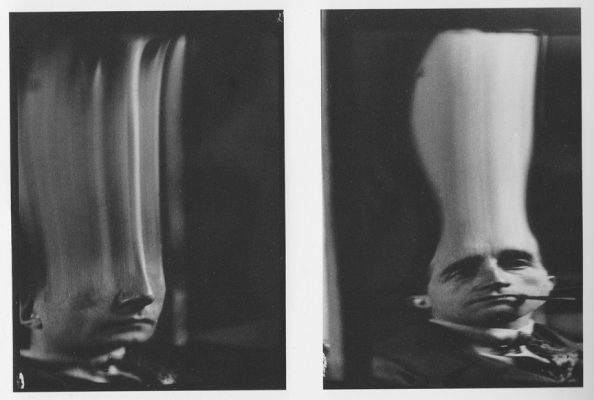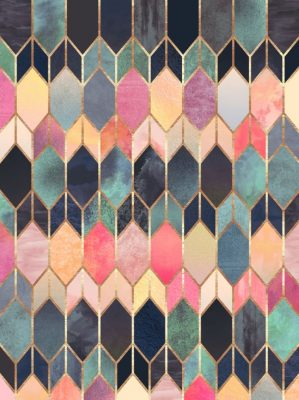‘The avant-garde can’t be ignored, so to ignore it – as most humanist British novelists do – is the equivalent of ignoring Darwin. Then you’re just a creationist.’
Tom McCarthy, in an interview with the Guardian
Art has renounced the desire to give form to the world. Having ceased to be modern, and finding it too passé to be postmodern, art is now merely contemporary, which seems to mean nothing more then yesterday’s art at today’s prices.
Mackenzie Wark, The Beach Beneath the Streets
There it is, ‘Fountain’, Duchamp’s notorious upturned urinal, signed in black paint R. Mutt. This one is a facsimile, the original having been lost in New York shortly after its rejection by the Society for Independent Artists in 1917. Today this replica of a readymade sits within a glass box in the Barbican’s art gallery; skeins of tourists surround it, awaiting enlightenment, snapping it on smart-devices, their faces stretched into that look of seriousness that avant-garde art seems uniquely placed to provoke. Would Duchamp laugh? I suspect he would.
The show in which ‘Fountain’ features brings together several of Duchamp’s most infamous pieces (or at least editions of them) with works by four American artists who loosely define Hal Foster’s neo-avant-garde as outlined in his Return of the Real (1996), namely John Cage, Merce Cunningham, Robert Rauschenberg and Jasper Johns. Viewing the exhibition is a strangely mute, oddly haunting experience. Here sat silent behind glass is Rauschenberg’s box of nails, an object that only gains meaning when it is shaken, a Cagean chance experiment in sound the performance of which is said to have evoked the pithy ‘I believe I’ve heard that tune before’ from Duchamp; an anecdote that serves to compound a view of him as the arch European sophisticate to his wide-eyed American puppy dogs. Over there are Cage’s visual scores, deadened under the white light of the sepulchral institution; they are the trace and shell of Cage’s joyful, democratic energy. Like the figures from Pompeii cast in volcanic rock that are drawing the crowds at the British Museum, these objects seem only able to whisper of a civilisation long past. In some ways they are even harder to hear, silenced both by a culture of museology that seeks to render them as heritage, and a branch of the art world that mourns and sacralises them as relics.
For many on the melancholic wing of the cultural Left, the historic avant-garde remains an admonishing, accusatory phantom. As an apparently lost moment in which art bound itself to the burning wheel of a revolutionary politics, it is seen to reflect a harsh light on the vulgar, commodified, institutionalised, globalised, faux-outrageous, faux-politicised art world we find ourselves operating in today. And yet, as with most things subject to nostalgia, the object of longing has been framed and simplified, fossilised in the experience of loss.
In Western Europe a phenomenon (at least in its primary ‘radical’ phase) triangulated between Zurich, Berlin and Paris, with satellites across the continent and in London, it has been customary to situate the avant-garde between the years 1910 and 1933, the year Weimar Dada was snuffed out by Hitler’s rise to power and the Nazis’ philistine suppression of what they deemed ‘decadent’. Its blast site was surely the Café L’Odeon in Zurich where James Joyce, Tristan Tzara, Jean Arp and Vladimir Ilyich Lenin drank during their self imposed exiles through the years of the First World War. Whether they ever spoke is unknown, but the history of culture, and history itself, exploded in momentous new directions from that watering hole.
In Russia the avant-garde is commonly understood to have started around 1895, but it was the October Revolution that triggered its short, brilliant, burning apotheosis. Lenin backed avant-garde culture as the art of the Revolution in the years immediately following 1917 and artists responded with a radical interpretation of a people’s art. Given ration cards and a propaganda budget, artists like Rodchenko, Tatlin and Popova dreamed a utopian culture of everyday life. They channeled the new energy of history into street parades, radical architecture, and even an agit-prop train that would travel to the provinces to show avant-garde film, put on performances of avant-garde plays and opera and distribute posters and literature. Little did they know that the hand of history would soon sweep aesthetics into the turgid bucket of Socialist Realism and avant-garde artists into the Gulag.
If the avant-garde’s central motive is, as the German critic Peter Bürger famously formulated it, the fusing of art and everyday life in the service of a radical politics, then it was theorised much earlier than any of this. The little known Fourieriste, Gabriel-Désiré Laverdant, in a work entitled De la Mission de l’art et du role des Artistes written three years before the 1848 Revolution, was possibly the first to affirm not only the connection between art and society so key for the revolutionary avant-garde, but also the doctrine of art as an instrument for radical action and social reform, a vessel for revolutionary propaganda and agitation:
Art, the expression of society, manifests in its highest soaring the most advanced social tendencies: it is the forerunner and revealer. Therefore, to know whether art worthily fulfills its proper mission as initiator, whether the artist is truly avant-garde, one must know where Humanity is going… To lay bare with a brutal brush all the brutalities, all the filth, which are at the base of our society.
It is necessary to note, as Renato Poggioli does in his 1962 study The Theory of the Avant Garde, that for Laverdant ‘the avant-garde[remains] subordinate, even within the sphere of art, to the ideals of a radicalism which was not cultural but political.’ Clearly and paradoxically the avant-garde here is equated with the realism that was so radically overturned by modernist doubt and avant-garde experimentalism in the early twentieth century.
In 1864 Baudelaire mentions ‘les littérateurs d’avantgarde’ in his personal notebook, Mon Coeur mis à nu. It comes at the end of a long list of examples meant to demonstrate the French fondness for military metaphors and it shows that the term must have been in relatively common use within the cultural sphere by the 1860’s. That the term remained important to the radical anarchistic and libertarian tradition throughout the nineteenth century is demonstrated by the fact that in 1878 Bakunin founded an agitatory political publication at Chaux de Fronds, Switzerland, called simply L’avant-garde.
Throughout the nineteenth century, then, the term is protean, moving through Zola’s realism to Mallarmé’s symbolism and on to Pater and Wilde’s decadence. Indeed, the Marxist critic Gyögy Lukács associates the radical avant-garde of the early twentieth century with the decadent, distinguishing the two only as different aspects of the degeneration of bourgeois culture.
The avant-garde is, as the poet Massimo Bontempelli maintained, ‘an exclusively modern discovery born only when art began to contemplate itself from a historical viewpoint’. That is to say the avant-garde is only possible after the French Revolution of 1789, and it is also to say that Romanticism stands in a paternal relationship to it. The avant-garde is only possible when art moves from being an aestheticist form of private pleasure, of taste, and takes on an active engagement within the public sphere. It is born of Shelley’s radically naïve belief that ‘poets are the unacknowledged legislators of the world’, a belief that would split dialectically into the cultural avant-garde on one side and the aestheticised politics of Fascism on the other.
Hal Foster has suggested that the avant-garde remains subject to metamorphoses. Foster, who came to prominence during the theory boom of the 1970s and 80s, makes the intriguing insight that critical theory ‘has served as a secret continuation of modernism’. In Return of the Real he writes:
After the decline of late modernist painting and sculpture it (critical theory) occupied the position of high art, at least to the extent that it retained the values of difficulty and distinction after they had receded from artistic form.
And he goes on:
So, too, critical theory has served as a secret continuation of the avant-garde by other means. After the climax of the 1968 revolts, it also occupied the position of cultural politics, at least to the extent that radical rhetoric compensated a little for lost activism.
However, as Mackenzie Wark notes on the fly in his 2011 history of the Situationists The Beach Beneath the Pavement, ‘If anything, theory has turned out even worse (than contemporary art). It found its utopia and it is the academy.’ Indeed, it is a popularly held view within cultural studies that the ’68 uprisings were the last genuine flowering of a politically emulsified avant-garde, the last moment – in the West at least – that art and politics met and worked towards a common aim before radical politics and contemporary art skulked off to their respective departments within the academy or under the bright lights of what Foster calls the ‘false pluralism of the posthistorical museum market where anything goes (as long as accepted forms predominate).’
So what should we make of Tom McCarthy’s claim that ‘to ignore the avant-garde is akin to ignoring Darwin’? The avant-garde was set in process by Nietzsche and his insistence on the aesthetic as the primary category of philosophical justification; one that could organise and subsume the logical and ethical concerns of social order. As Andrew J Walker maintains in his The European Avant-Garde (2004), art in twentieth century Europe ‘seizes the possibility of taking the place of a God declared dead’. This is what T.J Clark has called art’s ‘improbable claim’. To someone like McCarthy that claim needs to be worked through, but, importantly, not imitated. Indeed the dangers of such imitation are mapped out in his 2005 novel Remainder, in which the central character reenacts increasingly unhinged performances in pursuit of an experience of autonomous authenticity.
As our world accelerates into media saturation, info-glut, cyberwar, drone war, cultural commodification and the crushing victory of neo-liberal economics it is perhaps easy to see why the example of the historic avant-garde might be so beguiling to a generation of artists tasked with engaging with a world that feels explosively schizoid, crushingly leaden and ungraspable. But the fear is that the avant-garde becomes a kind of arcadia in itself. The truth might be that the very notion is a kind of chimera. In the end the avant-garde has a more complex relationship to history than Marinetti’s rhetoric of historical renewal might seem to suggest, for to propose an avant-garde is to take up a position that is at risk of being overtaken the very moment it is mapped out. The avant-garde is always caught in a dialectical bind, for as it seeks to suspend and destroy the canonical authority of tradition it becomes canonical itself, as demonstrated, to such depressing effect, by the show at the Barbican. As Walker puts it:
The cultural battle sustained by the avant-garde is a curiously self-reflective one. The avant-garde is at the leading edge, taking cultural practices forward into new territory but always by battling with that which it leads . . . Thus culture is always ready to accommodate the aggression of the avant-garde, to canonise its works of resistance, and the avant-garde is preoccupied in spite of itself with the history it would seek to outstrip.
A writer like McCarthy is too smart not to recognize this, his approach to the avant-garde is archaeological; he is a seeker of moments that might be used to activate a radical perspective on the present.
Perhaps we need to reframe our notion of what the avant-garde might be and engage the parallax view. We might reject the notion of the eschatological avant-garde, but hold out for the critic John Roberts’ reading of the neo-avant-garde through Adorno as not ‘the failed repetition of an original lost moment… [but] as aesthetically and critically equivalent to the early avant-gardes… Under conditions of the false sublation of art into everyday life in liberal democracy the avant-garde is an experience of art’s critical persistence, a continual restaging of art’s own promise.’




